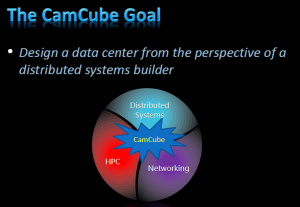Are routerless datacenters in Microsoft's future?

Microsoft Research is exploring a new way to connect servers directly to other servers, without the use of any switches or dedicated networking inside a datacenter container.
That project, known as CamCube, is one way that Microsoft execs are attempting to rethink the datacenter. More on that in a moment....
In the nearer term, Microsoft's various development teams are making their own tweaks to the fabric powering the company's existing and future cloud services.
Microsoft execs don't talk a lot publicly about the infrastructure that underlies its cloud platform. Global Foundation Services runs the "guts" of the cloud, and is responsible for tweaking the datacenter servers and services that power the customer-facing Microsoft cloud components, like Windows Live, Bing, Business Productivity Online Services, etc. GFS is the team that does a lot of the work to bring online new Microsoft datacenters, like the latest one in Boydton, Virg., that the Softies just announced they'll be building.
GFS is building a new Manageability Framework (MFx), according to a recent Microsoft job blog post, that will be replacing the current suite of GFS management tools which are "at lealst a decade old." (I'm thinking Microsoft's AutoPilot is an example of one such existing GFS tool.) MFx will include tools for server monitoring and deployment across datacenters, as well as the base for new datacenter-management apps that will run in massive fault-tolerant, distributed environments.
GFS works on problem solving, not just product development. Recently, GFS published a white paper with lessons learned around energy efficiencies realized via its IT Pre-Assembled Component (ITPAC) design. It has another paper on security best practices for those developing for and moving apps to Windows Azure.
But back to the future... CamCube is a research project (which may or may not ever see the light of commercialized day) via which Microsoft is looking at what designing a data center "from the perspective of a distributed systems builder" might look like.
(Click on slide above to enlarge. It's part of a presentation on CamCube from Microsoft Research Cambridge on the Trilogy.org project site.)
From a new Microsoft Research white paper entitled "Symbiotic Routing in Future Datacenters," there's a description of CamCube:
"The CamCube project explores the design of a ship-ping container sized data center with the goal of building an easier platform on which to build these applications. CamCube replaces the traditional switch-based network with a 3D torus topology, with each server directly connected to six other servers."
(Click on slide to enlarge) Microsoft researchers have been exploring, using CamCube, the feasibility of using "multiple service-specific routing protocols in a datacenter of the future," the paper explained. This would not require the use of switches or dedicated networking inside a datacenter container. Instead, it would rely on a "low-level link orientated API" (application programming interface) allowing services to implement their own protocols. If you dig into the Symbiotic Routing white paper, there are specifics on the team's ideas for a CamCube virtual-machine distribution service, a caching service, an aggregation service, and more.
The ultimate goal of CamCube is to increase networking performance in increasingly large datacenters that Microsoft, its partners and its customers are racing to build. When/how/if any of these concepts end up incorporated into Azure and GFS is anyone's guess....
